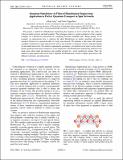| dc.contributor.author | Ajoy, Ashok | |
| dc.contributor.author | Cappellaro, Paola | |
| dc.date.accessioned | 2013-09-13T14:11:39Z | |
| dc.date.available | 2013-09-13T14:11:39Z | |
| dc.date.issued | 2013-05 | |
| dc.date.submitted | 2013-01 | |
| dc.identifier.issn | 0031-9007 | |
| dc.identifier.issn | 1079-7114 | |
| dc.identifier.uri | http://hdl.handle.net/1721.1/80713 | |
| dc.description.abstract | We propose a method for Hamiltonian engineering that requires no local control but only relies on collective qubit rotations and field gradients. The technique achieves a spatial modulation of the coupling strengths via a dynamical construction of a weighting function combined with a Bragg grating. As an example, we demonstrate how to generate the ideal Hamiltonian for perfect quantum information transport between two separated nodes of a large spin network. We engineer a spin chain with optimal couplings starting from a large spin network, such as one naturally occurring in crystals, while decoupling all unwanted interactions. For realistic experimental parameters, our method can be used to drive almost perfect quantum information transport at room temperature. The Hamiltonian engineering method can be made more robust under decoherence and coupling disorder by a novel apodization scheme. Thus, the method is quite general and can be used to engineer the Hamiltonian of many complex spin lattices with different topologies and interactions. | en_US |
| dc.description.sponsorship | National Science Foundation (U.S.) (Grant DMG-1005926) | en_US |
| dc.description.sponsorship | United States. Air Force Office of Scientific Research. Young Investigator Program | en_US |
| dc.language.iso | en_US | |
| dc.publisher | American Physical Society | en_US |
| dc.relation.isversionof | http://dx.doi.org/10.1103/PhysRevLett.110.220503 | en_US |
| dc.rights | Article is made available in accordance with the publisher's policy and may be subject to US copyright law. Please refer to the publisher's site for terms of use. | en_US |
| dc.source | APS | en_US |
| dc.title | Quantum Simulation via Filtered Hamiltonian Engineering: Application to Perfect Quantum Transport in Spin Networks | en_US |
| dc.type | Article | en_US |
| dc.identifier.citation | Ajoy, Ashok, and Paola Cappellaro. “Quantum Simulation via Filtered Hamiltonian Engineering: Application to Perfect Quantum Transport in Spin Networks.” Physical Review Letters 110, no. 22 (May 2013). © 2013 American Physical Society | en_US |
| dc.contributor.department | Massachusetts Institute of Technology. Department of Nuclear Science and Engineering | en_US |
| dc.contributor.department | Massachusetts Institute of Technology. Research Laboratory of Electronics | en_US |
| dc.contributor.mitauthor | Ajoy, Ashok | en_US |
| dc.contributor.mitauthor | Cappellaro, Paola | en_US |
| dc.relation.journal | Physical Review Letters | en_US |
| dc.eprint.version | Final published version | en_US |
| dc.type.uri | http://purl.org/eprint/type/JournalArticle | en_US |
| eprint.status | http://purl.org/eprint/status/PeerReviewed | en_US |
| dspace.orderedauthors | Ajoy, Ashok; Cappellaro, Paola | en_US |
| dc.identifier.orcid | https://orcid.org/0000-0003-0544-5263 | |
| dc.identifier.orcid | https://orcid.org/0000-0003-3207-594X | |
| mit.license | PUBLISHER_POLICY | en_US |
| mit.metadata.status | Complete | |
